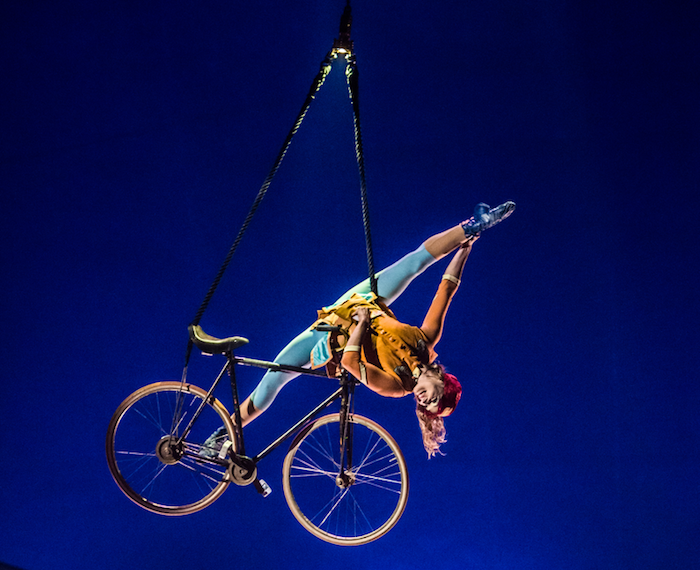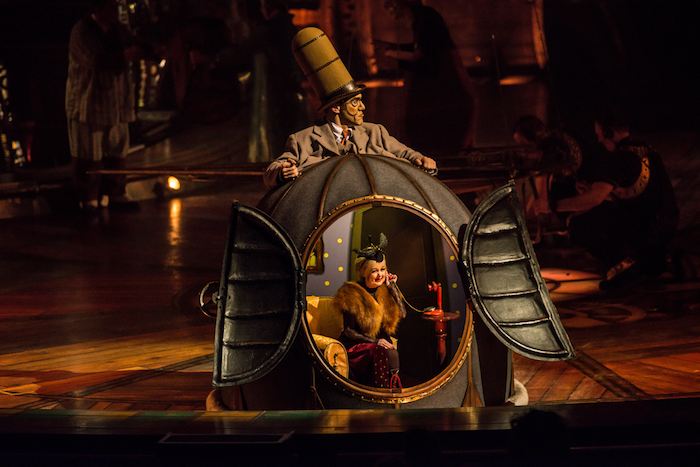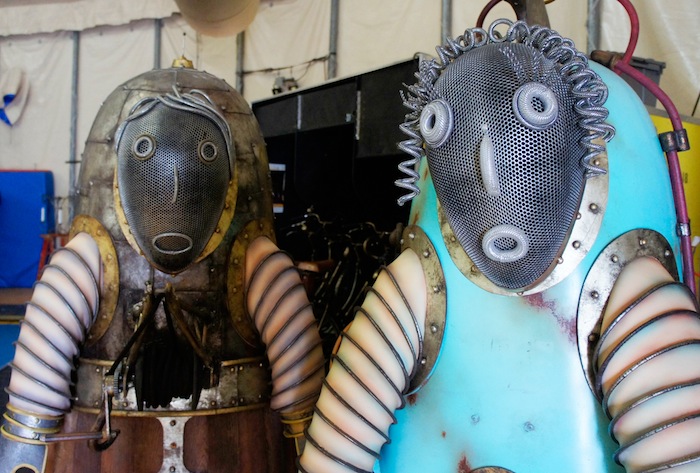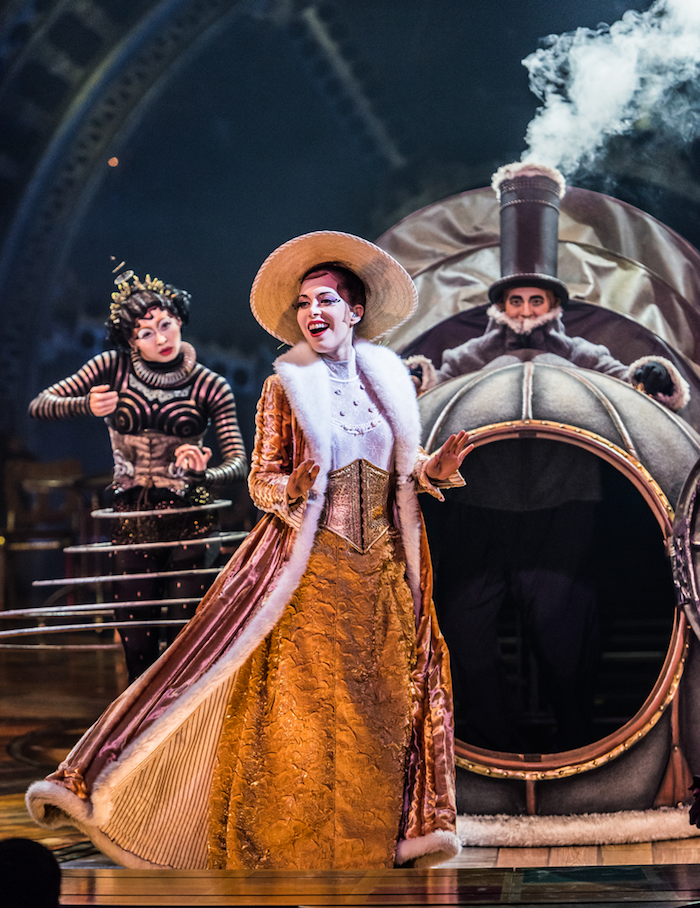Chances are if you've been, well, anywhere in Boston over the past few weeks you've seen the signs for Cirque du Soleil's show Kurios, showing under the Big Top at Suffolk Downs. If you're thinking about attending - stop thinking and get your tickets! Like all the Cirque performances I have seen, it is meticulously choreographed and completely filled with breathtaking performances - during each act I found myself grabbing Mr. TBF's arm, and whispering "Whaaaaaaat....?!?!?!" Since the show is under the Big Top (meaning it tours in its own circus tent, not at an arena) you get a close view of the performers, and, of course, their fantastic costumes. I spoke with Julie de Carufel, the Head of Wardrobe for Kurios, to get some insight into these fabulous pieces.
Tell me about your background with Cirque du Soleil. I have been with Cirque for a total of eight years. I'm from Montreal, and my educational background was in costuming. I grew up with Cirque (being from Montreal), so it was a natural choice to want to work here. When I joined, I worked in the studio that worked on all the costumes. Then I moved into a show (Corteo) that was already touring. I joined Kurios at its creation, so just before it opened in Montreal in November of 2013.
How was it coming to Kurios, which was a whole new show and costume concept, versus stepping in and working on an already designed and touring show? Every show has their own challenges and creations, depending on the choices that are made by the Director and the Costume Designer. The biggest challenge for creation in a newly designed show is finding the best way to operate the costumes. The costumes are created in Montreal, but then they need to be adapted to touring life. Closures (like snaps or zippers) may need to be adapted for quick changes. Some fabrics or trims need to be changed in order to be washable or dry cleanable. Most of it hopefully is done at creation, but throughout the lifespan of the show, which can last up to fifteen years, there are always adaptations that need to be made. For a show like this one, which will live at least ten years under the big top, it is inevitable that some fabrics may become unavailable from our suppliers, so new materials will need to be researched and tested, and patterns may need to be altered in order to work with the newly available materials. It is kind of a never-ending job!
The costumes evolve over time? The performers change, and their bodies change, because they train very hard all year long.
Are performers measured with you at Kurios, or do they go through Montreal? It is a case by case basis. Let's say they care Canadian; they can easily get to Montreal and have their measurements done, and have their head scanned (the head is round which makes it very difficult to measure; it is easier if we can exactly measure it by scanning). Our performers all do their own makeup, so they take lessons with makeup artists there and go through their application process step by step.
Some of the makeup is pretty extensive! Do they learn like paint-by-number or do they have a stencil or something for their face? It is kind of a paint-by-number! The makeup artists do a step, and take a photo, then another step, then another photo, so the performers literally have a step-by-step photo guide for their makeup. For very specific lines, sometimes they have stencils. It depends on the makeup, and it also depends on the talent of the person - some people have a better hand, and some people need a little more practice.
Like me! Tell me, what are some of your favorite costumes in the show? The main characters, Klara, Nico and Mr. Microcosmos - they are very special costumes. First, they are not traditional fabric. They are part carbon fiber, part cardboard, part foam, and the shapes are very interesting. All of their costumes become props - Klara, for example, manipulates her skirt to pick up alpha waves. Nico is called the Accordion Man because when he moves, it looks like an accordion. Mr. Microcosmos has this big belly, that actually opens up to be the house of the little person living in there. What is specific about this show is that the costumes really border on being props; there are not simple costumes.
That means they probably have a lot more wear and tear. The wear is very different - usually props are more heavily built, but these are handled as costumes - they have to be wearable - sturdy, but wearable. These are the type of costumes that the first prototypes are built a year and a half before the show even begins. We go through many iterations - they take much longer than a simple unitard, which Cirque really knows how to make. These costumes take months and months of trial and error. Jut think - Mr. Microcosmos' big belly - the costume, plus the person inside it - that's 80 pounds. So he is carrying 80 pounds with him throughout the show.
And I think it is hard to walk up the stairs when I am carrying, like, a bag of groceries and my laptop. Thankfully, he is an acrobat, right?
You can learn more about Kurios and purchase tickets here (the Boston show runs through July 10, 2016). Want to learn more about the Kurios characters? Take Cirque du Soleil's quiz to find out which Kurios character you are.
Keep up with TBF! Twitter | Facebook | Instagram | Pinterest | Snapchat: Bos_Fashionista | Bloglovin' | Follow by Email
Photos via Cirque du Soleil, except for photo 6 & 8.
Tell me about your background with Cirque du Soleil. I have been with Cirque for a total of eight years. I'm from Montreal, and my educational background was in costuming. I grew up with Cirque (being from Montreal), so it was a natural choice to want to work here. When I joined, I worked in the studio that worked on all the costumes. Then I moved into a show (Corteo) that was already touring. I joined Kurios at its creation, so just before it opened in Montreal in November of 2013.
How was it coming to Kurios, which was a whole new show and costume concept, versus stepping in and working on an already designed and touring show? Every show has their own challenges and creations, depending on the choices that are made by the Director and the Costume Designer. The biggest challenge for creation in a newly designed show is finding the best way to operate the costumes. The costumes are created in Montreal, but then they need to be adapted to touring life. Closures (like snaps or zippers) may need to be adapted for quick changes. Some fabrics or trims need to be changed in order to be washable or dry cleanable. Most of it hopefully is done at creation, but throughout the lifespan of the show, which can last up to fifteen years, there are always adaptations that need to be made. For a show like this one, which will live at least ten years under the big top, it is inevitable that some fabrics may become unavailable from our suppliers, so new materials will need to be researched and tested, and patterns may need to be altered in order to work with the newly available materials. It is kind of a never-ending job!
The costumes evolve over time? The performers change, and their bodies change, because they train very hard all year long.
Are performers measured with you at Kurios, or do they go through Montreal? It is a case by case basis. Let's say they care Canadian; they can easily get to Montreal and have their measurements done, and have their head scanned (the head is round which makes it very difficult to measure; it is easier if we can exactly measure it by scanning). Our performers all do their own makeup, so they take lessons with makeup artists there and go through their application process step by step.
Some of the makeup is pretty extensive! Do they learn like paint-by-number or do they have a stencil or something for their face? It is kind of a paint-by-number! The makeup artists do a step, and take a photo, then another step, then another photo, so the performers literally have a step-by-step photo guide for their makeup. For very specific lines, sometimes they have stencils. It depends on the makeup, and it also depends on the talent of the person - some people have a better hand, and some people need a little more practice.
Like me! Tell me, what are some of your favorite costumes in the show? The main characters, Klara, Nico and Mr. Microcosmos - they are very special costumes. First, they are not traditional fabric. They are part carbon fiber, part cardboard, part foam, and the shapes are very interesting. All of their costumes become props - Klara, for example, manipulates her skirt to pick up alpha waves. Nico is called the Accordion Man because when he moves, it looks like an accordion. Mr. Microcosmos has this big belly, that actually opens up to be the house of the little person living in there. What is specific about this show is that the costumes really border on being props; there are not simple costumes.
That means they probably have a lot more wear and tear. The wear is very different - usually props are more heavily built, but these are handled as costumes - they have to be wearable - sturdy, but wearable. These are the type of costumes that the first prototypes are built a year and a half before the show even begins. We go through many iterations - they take much longer than a simple unitard, which Cirque really knows how to make. These costumes take months and months of trial and error. Jut think - Mr. Microcosmos' big belly - the costume, plus the person inside it - that's 80 pounds. So he is carrying 80 pounds with him throughout the show.
And I think it is hard to walk up the stairs when I am carrying, like, a bag of groceries and my laptop. Thankfully, he is an acrobat, right?
You can learn more about Kurios and purchase tickets here (the Boston show runs through July 10, 2016). Want to learn more about the Kurios characters? Take Cirque du Soleil's quiz to find out which Kurios character you are.
Keep up with TBF! Twitter | Facebook | Instagram | Pinterest | Snapchat: Bos_Fashionista | Bloglovin' | Follow by Email
Photos via Cirque du Soleil, except for photo 6 & 8.









No comments :
Post a Comment